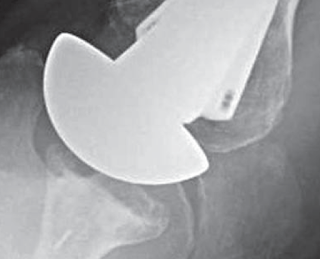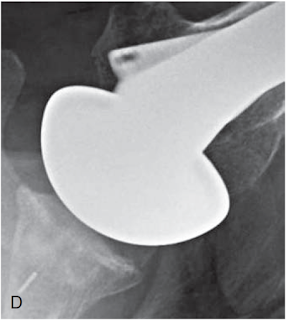It is estimated that 1% of total shoulder arthroplasties end out having revision surgery for subscapularis failure.
These authors reviewed their experience with patients undergoing reoperation for subscapularis (SC) failure after total shoulder arthroplasty. Patients underwent either revision SC repair (n=17) or revision to reverse shoulder arthroplasty (n=8).
Two thirds of these patients had had a lesser tuberosity osteotomy at the time of their initial total shoulder.
In two thirds of the cases subscapularis failure occurred without an injury.
Patients who initially underwent SC repair were significantly younger than patients who underwent revision to reverse shoulder arthroplasty (mean age, 59.3 years vs. 70.3 years; P = .004), had a better comorbidity profile (mean Charlson Comorbidity Index, 2.2 vs. 3.6; P = .04), and had a more acute presentation (mean time between injury and surgery, 9.1 weeks vs. 28.5 weeks; P = .03).
Patients who underwent SC repair also had a significantly higher reoperation rate (52.9% vs. 0.0%, P = .01).
At final follow-up, functional outcomes scores and patient satisfaction rates were not significantly different between treatment groups, but both groups had substantially lower final outcome scores compared with historical controls after uncomplicated anatomic TSA.
Comment: This study points out the importance of prevention of subscapularis failure after shoulder arthroplasty. The integrity of a subscapularis repair depends on four key elements:
(1) the pre-incision quality of the tendon
(2) the technique with which it is incised from the humerus
(3) the security of the reattachment to bone, and
(4) the rehabilitation of the shoulder in a way that protects the subscapularis repair from external rotation stretching or active internal rotation loads.
Our surgical approach to subscapularis management can be used with any prosthesis. It involves a careful peel of the subscapularis tendon from the lesser tuberosity with attention to preserving the integrity of the biceps tendon and a 360 degree release of the capsule from the glenoid to resolve limitation of external rotation. By retaining the capsule on the deep surface of the tendon, the strength of the repair is enhanced.
These sutures are then passed through the tendon edge, including the capsule retained on its deep surface, and tied securely.
Of these the most important stitch is the superior one (the "mother stitch") in that this suture takes the most load when the arm is externally rotated. See The biomechanics of subscapularis repair - all sutures are not equal!
A principal cause of post operative subscapularis failure is the overzealous and premature stretching of external rotation or premature initiation of internal rotation strengthening. We limit external rotation stretching to zero degrees (the hand shake position) and avoid internal rotation strengthening exercises for at least 3 months after surgery.
We also caution patients about the risk of events that may suddenly externally rotate the shoulder such as a fall or a sudden pull on the arm from a leashed dog.
At the conclusion of the case, drill holes are placed through good bone at the margin of the neck cut and six sutures of #2 non-absorbable suture are passed through these holes. The security each suture is verified to make sure it does not pull through the bone.
A principal cause of post operative subscapularis failure is the overzealous and premature stretching of external rotation or premature initiation of internal rotation strengthening. We limit external rotation stretching to zero degrees (the hand shake position) and avoid internal rotation strengthening exercises for at least 3 months after surgery.
We also caution patients about the risk of events that may suddenly externally rotate the shoulder such as a fall or a sudden pull on the arm from a leashed dog.
Signs of subscapularis failure in include excessive passive external rotation
When a subscapularis repair fails, the tendon is in worse condition than it was at the index arthroplasty.
As the authors of this paper point out, a reverse total shoulder is also an option.
Other related posts are listed below:
Subscapularis failure after arthroplasty - evaluation and management
Subscapularis in shoulder arthroplasty
Shoulder joint replacement arthroplasty - spare the subscapularis, spoil the arthroplasty?
How well does the subscapularis work after total shoulder arthroplasty? ?Hazards of inter scalene block?
Failure of lesser tuberosity osteotomy in total shoulder joint replacement - a cautionary tale
==
To see a YouTube of our technique for total shoulder arthroplasty, click on this link.
===
How you can support research in shoulder surgery Click on this link.
To see our new series of youtube videos on important shoulder surgeries and how they are done, click here.
Use the "Search" box to the right to find other topics of interest to you.
You may be interested in some of our most visited web pages arthritis, total shoulder, ream and run, reverse total shoulder, CTA arthroplasty, and rotator cuff surgery as well as the 'ream and run essentials'
and weakness of the belly press
and sometimes anterior instability.
Thus attempting a "repair" by trying to sew the tendon back again is likely to fail.
When we see a patient with chronic subscapularis failure, we place the patient on an exercise program to strengthen the other internal rotators or the shoulder (pectorals and teres major).
For patients with traumatic failure or those who have symptomatic refractory chronic failure, we discuss a reconstruction using a hamstring allograft to reinforce the reattachment.
As the authors of this paper point out, a reverse total shoulder is also an option.
Other related posts are listed below:
Subscapularis failure after arthroplasty - evaluation and management
Subscapularis in shoulder arthroplasty
Subscapularis and shoulder arthroplasty
The subscapularis - does it ever recover after shoulder arthropllasty - peel vs LTO?
The subscapularis - does it ever recover after shoulder arthropllasty - peel vs LTO?
==
To see a YouTube of our technique for total shoulder arthroplasty, click on this link.
===
How you can support research in shoulder surgery Click on this link.
To see our new series of youtube videos on important shoulder surgeries and how they are done, click here.
Use the "Search" box to the right to find other topics of interest to you.
You may be interested in some of our most visited web pages arthritis, total shoulder, ream and run, reverse total shoulder, CTA arthroplasty, and rotator cuff surgery as well as the 'ream and run essentials'













